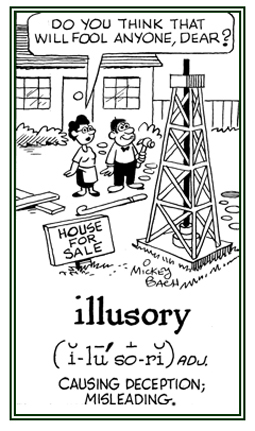You searched for:
“more illusory”
illusory (adjective), more illusory, most illusory
Produced by, based on, or having the nature of a mistaken perception of reality: Tom's florid and illusory language made his audience believe that beauty existed even in the town dump.

© ALL rights are reserved.
Go to this Word A Day Revisited Index
A world without color appears to be missing crucial elements
Colors not only enable us to see the world more precisely, they also create emergent qualities that would not exist without them.
Many people believe that color is a defining and essential property of objects, one depending entirely on the specific wavelengths of light reflected from them.
- Color is a sensation created in the brain.
- If the colors we perceived depended only on the wavelength of reflected light, an object's color would appear to change dramatically with variations in illumination throughout the day and in shadows.
- Instead, patterns of activity in the brain render an object's color relatively stable despite changes in its environment.
- The pathway in the brain that serves navigation and movement is essentially color-blind.
- People who become color-blind after a stroke appear to have normal visual perception otherwise.
- The study of illusory colors (colors that the brain is tricked into seeing) demonstrates that color processing in the brain occurs hand in hand with processing of other properties; such as, shape and boundary.
- Visual perception begins with the absorption of light; or, more precisely, the absorption of discrete packets of energy called photons; by the cones and rods located in the retinas of the eyes.
- A cone photoreceptor responds according to the number of photons it captures, and its response is transmitted to two different types of neurons, termed on and off bipolar cells.
- These neurons in turn provide input to on and off ganglion cells that sit side by side in the retina.
- About 40 percent or more of the human brain is thought to be involved in vision.
- Visual signals disperse to more than 30 different areas, interconnected by more than 300 circuits.
- The complexity of color illusion suggests that it is unlikely to result from a single unitary process, but may represent an attempt by the brain to reconcile competing signals from multiple specialized pathways.
- The study of illusory colors demonstrates that the perception of color in the brain generates emergent properties of form and depth.
- Ongoing research about illusory colors will continue to offer a tantalizing portal into the complexities of the human visual system.

